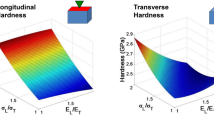Summary
Comparisons are made between predictions from a multi-surface representation of the hardening behaviour in polycrystalline materials and experimental results. In general, good agreement is found for the deformation behaviour, i.e. non-linear stress-strain response, a rotation in the plastic strain path and the Bauschinger effect, under stress paths which change direction. It is further shown that the model supplies more reliable predictions to the observed behaviour than those corresponding to the isotropic and kinematic hardening rules. The valid range of application for the latter rules is also clarified. The limitations of the multi-surface model, in particular, are discussed in respect of initial material anisotropy and from a cyclic loading test with ratcheting.
Similar content being viewed by others
Abbreviations
- A, n :
-
constants in the hardening law
- E, v :
-
elastic constants
- f :
-
equi-strain surface function
- F :
-
isotropic hardening function
- p :
-
plastic strain increment ratio
- R :
-
stress ratio
- Y :
-
uniaxial yield stress
- α, β, ϑ:
-
translation components
- δ, τ:
-
normal and shear stress components
- \(\bar \sigma\) :
-
equivalent stress
- δ':
-
deviatoric stress
- ε, γ:
-
normal and shear strain components
- \(\bar \varepsilon ^P\) :
-
equivalent plastic strain
- \(\Delta \bar \varepsilon ^P , d\bar \varepsilon ^P\) :
-
equivalent plastic strain increments
- σ:
-
Kronecker delta
- i, j, k :
-
tensor subscripts
- r, ϑ,z :
-
polar co-ordinate subscripts
- q :
-
subscript denoting surface number
- e, P, t :
-
strain superscrips
References
Rees, D. W. A.: A multi-surface representation of anisotropic hardening and comparisons with experiment. Proc. I. Mech. E.198 C (16), 269–284 (1984).
Rees, D. W. A.: Yield surface motion and anisotropic hardening, in: Applied solid mechanics 1 (Tooth, A. S., Spence, J., eds.) pp. 159–189. United Kingdom: Elsevier Appl. Sci. 1986.
Shiratori, E., Ikegami, K., Yoshida, F.: Analysis of stress-strain relations by use of an anisotropic hardening plastic potential. J. Mech. Phys. Sols.27, 213–229 (1979).
Hill, R.: The mathematical theory of plasticity. Oxford University Press 1950.
Rees, D. W. A.: Biaxial creep and plastic flow in anisotropic aluminium. Ph.D. thesis C.N.A.A. (United Kingdom), 1976.
Rees, D. W. A.: An examination of yield surface distortion and translation. Acta Mech.52, 15–40 (1984).
Ikegami, K.: An historical perspective of the experimental study of subsequent yield surface for metals — Parts 1 and 2, B.I.S.I. 14420, Sept. 1976, The Metals Soc. London [also J. Soc. Mat. Sci.24 (261), 491–505 (1975);24 (263), 709–719 (1975)].
Rees, D. W. A.: Yield functions that account for the effects of initial and subsequent plastic anisotropy. Acta Mech.43, 223–241 (1982).
Ziegler, H.: A modification to Prager's hardening rule. Quart. Appl. Math.17, 55–65 (1959).
Mroz, Z.: Mathematical models of inelastic material behaviour. Solid Mech. Div., Univ. of Waterloo 1973.
Taylor, G. I., Quinney, H.: The plastic distortion of metals. Phil. Trans. Roy. Soc.230A, 323–362 (1931).
Mair, W. M., Pugh, H. Ll. D.: Effect of prestrain on yield surfaces in copper. J. Mech. Eng. Sci.6, 150–163 (1964).
Rogan, J., Shelton, A.: Effect of pre-stress on the yield and flow behaviour of En 25 steel. J. Strain Anal.4 (2), 138–161 (1969).
Shahabi, S. N.: Creep and flow behaviour of steels under varying biaxial stresses. Ph.D. thesis, University of London 1971.
Shahabi, S. N., Shelton, A.: The anisotropic yield, flow and creep behaviour of prestrained En 24 steel. J. Mech. Eng. Sci.17 (2), 93–104 (1975).
Rees, D. W. A.: Applications of classical plasticity theory to non-radial loading paths, Proc. Roy. Soc. Lond. A410, 443–475 (1987).
McComb, H. G.: Some experiments concerning subsequent yield surfaces in plasticity. NASA Tech. Note D-396, June 1960.
Shaw, F. S., Wycherley, G. W.: Experiments on the plasticity of metals I — The octrahedral shear stress loading criterion. Sruct. and Materials, Aero Res. Lab. Note 181, Melbourne, Australia 1950.
Rees, D. W. A.: The neutral loading condition in classical plasticity theory. Int. J. of Plasticity, in press.
Ohashi, Y., Kawai, M., Kaito, T.: Inelastic behaviour of type 316 stainless steel under multi-axial non-proportional cyclic stressings at elevated temperature. J. Eng. Mat. and Tech. ASME107, 101–109 (1985).
Moyar, G. J., Sinclair, G. M.: Cyclic strain accumulation under complex multi-axial loading, in: Joint Int. Conf. on Creep, I. Mech. E./ASME2 (35), 45–57 (1963).
Author information
Authors and Affiliations
Additional information
With 13 Figures
Rights and permissions
About this article
Cite this article
Rees, D.W.A. An experimental appraisal of the equi-strain multi-surface hardening model. Acta Mechanica 70, 193–219 (1987). https://doi.org/10.1007/BF01174655
Received:
Issue Date:
DOI: https://doi.org/10.1007/BF01174655




